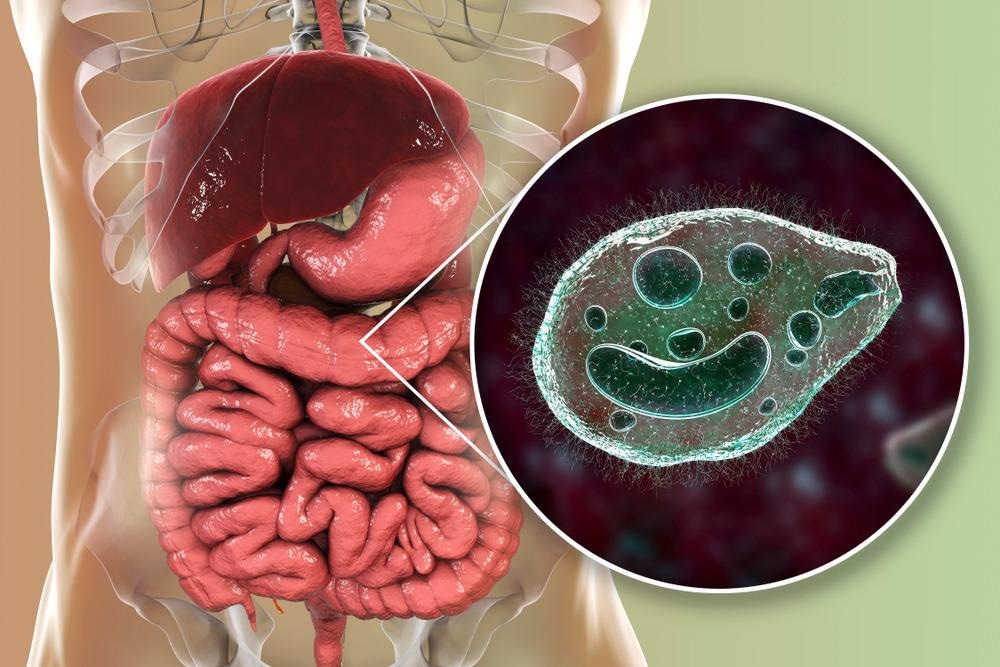Balantidiasis, also known as balantidiosis or ciliary dysentery is a rare complication of the intestine. A ciliated protozoan Balantidium coli infects the intestine and causes complications leading to balantidiasis. Balantidium (largest protozoan) is the only ciliate capable of infecting humans. Most often people with the infection show no symptoms at all. Some may experience mild symptoms like diarrhea and abdominal discomfort.

Image Credit: Kateryna Kon/Shutterstock.com
Cause and Symptoms
Balantidiasis is an uncommon infectious condition caused by Balantidium coli, a single-celled parasite. With zoonotic transmission, this protozoan infects a variety of hosts, including humans. B. coli can be transmitted to people either directly or indirectly by contact with pig excrement or drinking contaminated water. Poor diet, a weakened immune system, or other ailments can render a person more susceptible to the disease's more severe symptoms. The parasite, which can be found in the large intestine and other organs, can cause serious illnesses and even death.
B. coli is the parasite that most commonly infects humans, other primates, and pigs. This protozoon can be found all over the world, however, it only occurs in about 1% of cases. Infection is rare, although it is more likely to develop in areas where humans coexist with pigs and where water sanitation is poor.
Balantidiasis affects the majority of persons who are asymptomatic or have minimal symptoms. Acute illness can occur in some people, resulting in excessively high temperatures, stomach pain, vomiting, and bloody diarrhea. Balantidium coli is normally found in the lumen of its host, but the trophozoites produce ulcers in the mucosa of the large intestine (cecum and colon).
The parasite secretes a chemical called hyaluronidase enzyme, which aids in the decomposition of intestinal tissue and allows mucosal penetration. In addition to Balantidium coli, other bacteria in the colon may enter the ulcer, causing secondary infections. In immunocompromised patients, symptoms can be severe or lethal.
Rare Reports
Balantidiasis, a zoonotic disease affecting humans has been reported in the literature with several other medical conditions. A study from 2016 reported a COPD (chronic obstructive pulmonary disease) patient with urinary balantidiasis. In an unusual case, the patient was taking steroid medications for a long time.
The patient showed no signs and symptoms indicating a urinary or bowel involvement. Another case study from 2014 presented an elderly farmer with balantidiasis. He was suffering from two other complications including, diabetes and chronic kidney disease.
Balantidium Coli – Life Cycle
B. coli is a large ciliated protozoan. The life cycle of the protozoan comprises four stages: cysts, trophozoite, binary fission, and encystation. The first stage (Cysts) is when the transmission of the balantidiasis disease occurs. Following this is an intermediate stage wherein the cyst reaches its infecting capabilities. As B. coli is transmitted via the mouth route, the host acquires the infectious cyst through contaminated food or water. Excystation occurs in the small intestine after ingestion, and the large intestine gets colonized by trophozoites.
The trophozoites replicate through binary fission in the lumen (appendix and large intestines) of humans and animals where they live. To form infective cysts, trophozoites undergo encystation. Some trophozoites infiltrate and multiply in the colon's wall, causing ulcerative disease. Some dissolve when they return to the lumen. Cysts that have reached the stage of maturity are passed through the feces.
Epidemiology
Balantidiasis is an uncommon infection that equally affects males and females. It's most common in tropical areas like Brazil, New Guinea, and southern Iran. A systematic review and meta-analysis were conducted recently taking into account articles published on balantidiasis.
The study found that a large majority of these pieces were published in South America and Asia, mostly in Brazil and India. In Africa, however, Ethiopia had the highest number of infected people (47.5%). As more than 16% of affected people were close to pigs and/or their excreta, there was a significant correlation (p<0.05) between proximity to pigs and B. coli positivity.
Diagnosis and Treatment
Balantidiasis is detected through stool testing in a laboratory. In most cases, trophozoites (immature B. coli parasites) may be recovered from the stool. Scraping the ulcer and inspecting the tissue for trophozoites is a more complicated and invasive diagnostic procedure.
The presence of trophozoites in stool samples from symptomatic individuals or tissue retrieved during endoscopy is used to make the diagnosis. Cysts are less common, and they're more likely to be discovered in the produced stool. Balantidium coli is passed infrequently and is quickly eliminated once outside the colon. In certain cases, Lugol's iodine is used for staining.
Tetracyclines, metronidazole, and iodoquinol are used to treat balantidiasis most frequently. Tetracycline is the most common antibiotic used to treat Balantidiasis. When tetracycline cannot be given due to an allergy, iodoquinol or metronidazole may be used as a substitute. A person with Balantidiasis does not need to be isolated (quarantined). Infected people's feces, on the other hand, must be disposed of so that they do not contaminate drinking water or food supplies.
References:
- da Silva, R., Dib, L. V., Amendoeira, M. R., Class, C. C., Pinheiro, J. L., Fonseca, A., & Barbosa, A. (2021). Balantidiasis in humans: A systematic review and meta-analysis. Acta tropica, 223, 106069. https://doi.org/10.1016/j.actatropica.2021.106069
- Qadir, M. I., & Akmal, T. (2019). Perception of people about a ruthless disease balantidiasis?. transfusion, 60, 18. Available at: https://www.researchgate.net/profile/M-Qadir/publication/333207959_Perception_of_people_about_a_ruthless_disease_balantidiasis/links/5ce2478292851c4eabafa25d/Perception-of-people-about-a-ruthless-disease-balantidiasis.pdf
- (2019). Balantidiasis. [Online] Centers for Disease Control and Prevention. Available at: https://www.cdc.gov/dpdx/balantidiasis/index.html
- Kaur, S., & Gupta, A. (2016). Urinary balantidiasis: A rare incidental finding in a patient with chronic obstructive pulmonary disease. Journal of cytology, 33(3), 169–171. https://doi.org/10.4103/0970-9371.188063
- Karuna, T., & Khadanga, S. (2014). A rare case of urinary balantidiasis in an elderly renal failure patient. Tropical parasitology, 4(1), 47–49. https://doi.org/10.4103/2229-5070.129165
- Balantidiasis. [Online} National Organization for Rare Disorders. Available at: https://rarediseases.org/rare-diseases/balantidiasis/
Further Reading